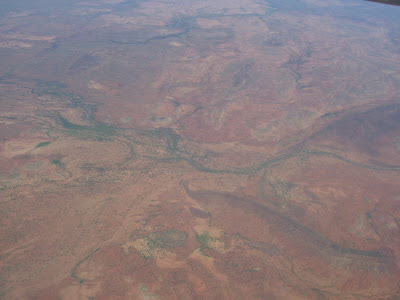During lunch, David and I talked over our plate of the restaurant's still hot Malaysian food. We joked about what we would do if this blackout affected more than Alice Springs. What if the power were out pretty much worldwide as happened in the sci-fi classic we watched this summer, "The Day the Earth Stood Still"? What if, unlike that movie, the blackout wasn't a brief one caused by a benevolent alien? How would we cope in the Outback without modern technology?
This is a picture of I took from the plane on the approach to Alice Springs. This land is the equivalent for that town of Fairfax County to Washington, D.C. , or Westchester County to New York. It is all parched red dirt and scrub as far as the eye can see.

My husband is a resourceful fellow. David created his own Tivo-like system for recording television shows, using the Linux computer-operating system. We call it Divo. He also rigged a hanger for a giant upside-down indoor tomato plant we had, using bits of wood and two kitchen sponges. Me, I once found my way back to Beijing on public buses after getting separated from a tour group miles from the city, and have made myself two mermaid costumes for recent Halloweens.
What good would this do us in the parched Australia Outback, the most inhospitable region in what the Lonely Planet calls a "geologically comatose" continent? The lights flicked back on before we got much beyond saying, "It would be a hell of a walk to the coast." We finished our lunch and strolled off for ice cream and then checked out these murals. They show the early years for Alice Springs, including the introduction of camels to the regions by an Afghani immigrant.



Flies, Flies, Flies
The Outback is a place that can turn even the occasional gifts of nature
into drawbacks. There had been an unusually heavy rain in the months proceeding our visit. This seemed mostly a boon to the flies.
People in Alice Springs continually passed their hands across their faces to shoo away flies. The flies seemed to target the nose and eyes. I think seeing a lazy wave of a hand across the face will long remind me of Alice Springs. It's like how a dancer's hand contorted, with fingers bent backward, says Bali to me and a gentle left-right, left-right shake of the head speaks of the south Indian state of Tamil Nadu.
The flies were a nuisance in Alice Springs. In the Outback, they were like something from a horror movie. We stopped at a picnic table on our five-hour drive to Uluru, the giant red rock that is the main draw for Alice Springs. The flies swarmed. We beat the air around our heads with our hands, now spastic like whoever was the least graceful of the Three Stooges.
No picnic for us. We got back on the road. Bleached kangaroo skeletons lay here and there along the highway to Uluru.The skeletons look eerily human, because kangaroos stand upright and can be as tall as people. While kangaroos lose a lot of battles with cars and trucks, they have adapted well to the heat. Their intestines push up into their lungs when they jump, help expel air and relieving chest muscles some work.
David was disappointed that we didn't see live kangaroos on our drive, only roadkill. I was relived that we didn't see any kangaroos bound into our path and become roadkill. When we did see kangaroos later at Sydney's Taronga Zoo, they were laying, staying idle in the hot hours of the day. David and I usually choose to continue racing about even then, much like Noel Coward's "mad dogs and Englishmen (who) go out in the noonday sun.''

The native people of Australia also have learned how to cope with heat. They sit. The paintings of Aborigines use a semicircle to denote a person, a shorthand for the cross-legged position often used to sit on the ground. In Alice Springs, we passed groups of Aborigines sitting in the parks and even on the hospital lawn in the evening. They were speaking to each other in one of the native languages.
A staff member at my favorite Alice Springs gallery, Yanda Aboriginal Art,
told me that a circle placed near the semicircle shows the person is a woman. It signifies a bowl she would keep handy, to work as she sat. A long oblong near the semicircle denotes a man. It represents his spear.
None of the galleries we visited in Alice Springs allowed photography, a reasonable yet disappointing restriction. The picture below is an example of Aboriginal art that appears on the handout at Uluru. The circle of semicircles represents the board that runs the park site, with different colors for the Aborigines and the non-Aborigines.

And here's an Alice Springs trash can decorated quite nicely.

My favorite painting at Yanda had a nice rectangular pattern to its lines and dots. The staff member there explained that they represented where to find to food and water. Many of the beautiful Aborigine paintings we see today grew from a tradition of making maps, from traditions people used to cope in the Outback centuries before there were air-conditioning restaurants and refrigerated food-delivery trucks.




No comments:
Post a Comment